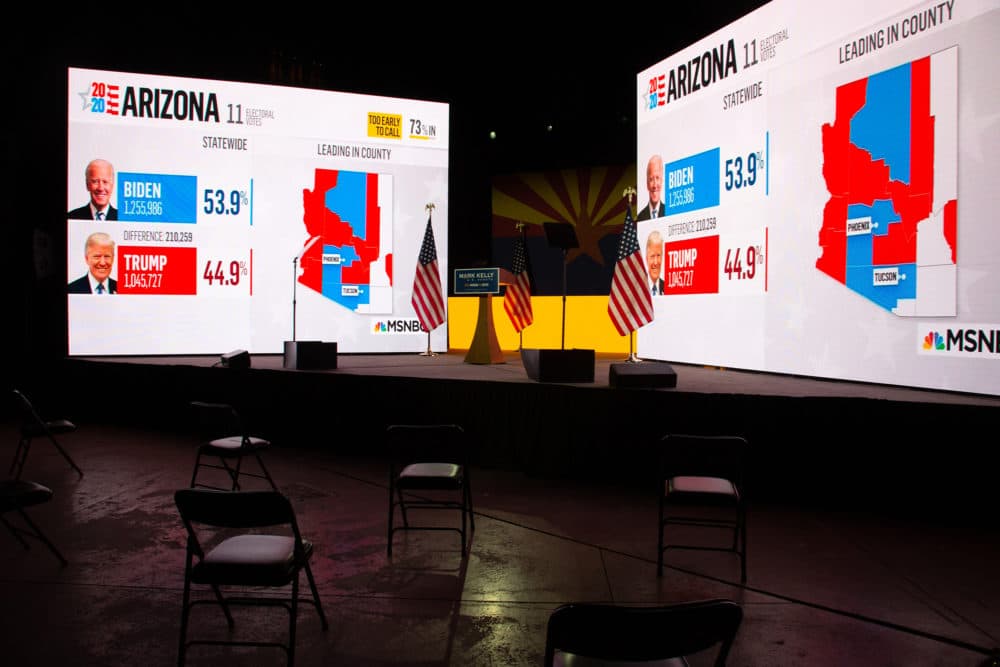Advertisement
Here & Now's 2020 Election Coverage
Democrats Make History In Changing The Southwest
Resume
The blue wave didn't materialize in the way Democrats hoped in the 2020 election, but some history was made in the southwestern United States.
As political analyst Ron Brownstein points out, Democrats will hold all the Senate seats in Arizona, Colorado, Nevada and New Mexico for the first time since 1941. And the Democrats will hold all of those seats and the presidency for the first time since 1936.
This year’s high voter turnout stemmed from the political mobilization that preceded the election, says Celeste Montoya, professor of political science at the University of Colorado Boulder.
Activists in Arizona say the mobilization of groups such as young immigrants and first-time voters played a role in electing Democrat Mark Kelly to the Senate and Joe Biden to the White House — marking the first time the state went blue in a presidential election since the 1990s.
“We saw voters who had previously not participated in the system showing up in huge numbers, Latino voters in particular,” Montoya says. “And those are a strong growing group within the Southwest in New Mexico, Texas, Arizona, Colorado and Nevada, all of those places.”
This transition is all the more remarkable considering the deep conservative tradition of the western U.S. The change might seem dramatic, but this political shift in the Southwest has been underway for years, says Robert Lang, professor of public policy at the University of Nevada Las Vegas and co-author of “Blue Metros, Red States: The Shifting Urban-Rural Divide in America’s Swing States.”
Colorado has been on track to become a blue state, he says, so running a moderate Democrat like former Gov. John Hickenlooper worked in the Senate race. Winning is tougher for Democrats in places like Arizona, which is new to the group of swing states in the Southwest after many decades of loyalty to Barry Goldwater and John McCain. Both of those men served long terms as Republican senators and ran for president.
Along with Native American voters, the affluent suburbs where Goldwater lived in Paradise Valley and neighboring Scottsdale are largely responsible for the state’s political shift, Lang says.
“Those places where Goldwater lived that had the mid-century modern housing, that was the beautiful people's space of 1960 and was rock-ribbed Republican,” he says, “that's the very area that because of the modern world of Phoenix, its diversity, you might as well be in the North suburbs of Atlanta. The same things happening there.”
Before World War II, cities like Phoenix and Las Vegas were mere dots on the map. Now, people from around the country, particularly the Northeast and California, flock there, Lang says.
Lang looked at eligible voters in Nevada’s Clark County, which includes Las Vegas and determines the state’s outcome in elections, in 2010. Only one in 10 voters were born in the state, he says, compared to three in 10 born in California.
These figures demonstrate the emergence of the Sun Belt. Because of the region’s strong connection to the state, the Southwest now functions as an extension of California, he says.
“The region went from this dusty backwater to this global space that is really sort of the interior parts of California at this point, politically,” he says, “more so than they reflect their earlier historic traditions, which you see hanging on in the northern Rockies.”
In the post-war years, the political conversation in the Southwest centered around public land use, rugged individualism and water policy. Now, those issues are still important but no longer front and center.
Views on access to land and a few other “residual habits” may set a westerner apart from voters from the East, Lang says. Bigger concerns for southwestern voters now include the quality of schools and how to diversify the economy.
Southwest states have learned to develop workforces that can sustain companies from California looking to open facilities in cheaper areas, he says. Think Tesla’s factory outside of Reno, Nevada, or Intel near Phoenix, for example.
This relationship between California businesses and Southwest cities could impact low cost, high skill cities such as Salt Lake City and Boise, Idaho. These cities could flip more states blue sometime in the distant future, he predicts.
“Salt Lake City doesn't vote like the rest of the state already,” he says. “Give it enough time, you could actually override even the sort of strong Mormon presence in parts of the West like Idaho and Utah.”
Cities like Phoenix, Denver, Las Vegas and Albuquerque make up a large portion of each state’s vote. But unlike in the Southeast, places in the Mountain West such as ski towns in Colorado and college towns like Flagstaff, Arizona, favored the Democrats, Lang says.
Lang predicts scenic parts of the Mountain West will also go blue in time.
“The West's pretty spaces are being peopled by former urbanites who've decided they've got enough internet access to make a go of it,” he says. “And they start these little restaurants and microbreweries. And the next thing you know, it's not like the Great Plains rural parts. Ain't nobody doing that in the Great Plains.”
Arizona, Colorado and Nevada will all gain electoral votes in time as well, he says. Coupled with the blue wall on the West Coast, competitive Mountain West states and opportunities for the Democrats in the Southeast such as Georgia and North Carolina could mean trouble for the Republicans in future elections, he says.
“The Republicans would really have to rethink their entire strategy for elections and begin to accommodate the country as it is, rather than the country that they'd prefer it was,” he says.
Alex Ashlock produced this story and edited it for broadcast with Chris Bentley. Allison Hagan adapted it for the web.
This segment aired on November 30, 2020.

